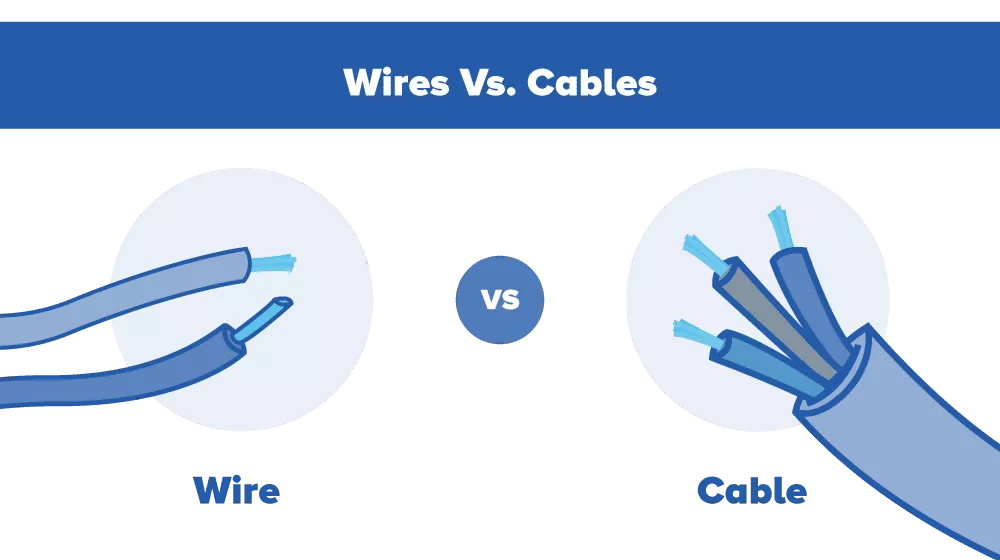
What is a Wire?
A wire is a single, usually cylindrical, the conductor made of metal or other conductive material used to transmit electrical signals, power, or data over short distances. Wires are used in many electrical and electronic applications, such as in power distribution, communications, and data transmission systems. They can be made from various materials including copper, aluminum, and steel and come in different shapes, sizes, and insulation materials.
Wires are typically characterized by their cross-sectional area, also known as their gauge, which determines the amount of current they can safely carry. They may also be classified by their intended use, such as high-temperature wires for furnace and oven use, or high-frequency wires for signals in microwave or fiber optic communications. Wires are commonly found in electrical and electronic devices, power cables, wiring harnesses, and in building electrical installations. They can be connected to other components through soldering, crimping, or other methods, and are often covered in insulation materials to prevent electrical interference and protect against electrical shock.
Types of Wires
Solid Wires: A solid wire is a type of electrical wire that has a solid, continuous conductor instead of a stranded conductor. It is used for low voltage and low current applications, such as in the internal wiring of electrical appliances and devices. Solid wire is usually less flexible than stranded wire, but it is more durable and easier to work with.
Standard Wires: Standard wires refer to electrical wires that conform to widely accepted industry or government standards. These standards may specify the size, material, insulation, color coding, and other properties of the wire. Examples of such standards include:
- UL (Underwriters Laboratories) Standards for Safety
- National Electrical Code (NEC)
- International Electrotechnical Commission (IEC) Standards
Standard wires are used in a variety of applications, from residential and commercial electrical wiring to automotive and industrial systems. The use of standard wires helps ensure safety and compatibility across different systems and equipment.
What is a cable?
A cable is a bundle of multiple electrical wires or fibers that are enclosed in a common insulation and jacket. Cables are used for transmitting electrical power or data signals over long distances. They are commonly used through various applications, including:
- Electrical power distribution in buildings, factories, and power grids
- Data communication networks, such as Ethernet or fiber-optic networks
- Television and audio-visual equipment
- Automotive and industrial systems
- Telecommunications
Cables come in different sizes and configurations, depending on the specific requirements of the application. For example, electrical power cables may have thicker wires and higher insulation to handle higher voltages and currents, while data cables may have finer wires and specialized insulation for transmitting data signals at high speeds.
Types of Cables:
Fiber Optical Cable: A fiber optical cable is a type of cable that is used to transmit data using light signals over optical fibers. It consists of one or more optical fibers (thin strands of glass or plastic) surrounded by protective insulation and a protective outer jacket.
Fiber optic cables have several advantages over traditional copper wires:
- Higher bandwidth: Fiber optic cables can transmit data at much higher speeds and greater distances than copper wires.
- Immunity to interference: Light signals in fiber optic cables are immune to electromagnetic interference, making them ideal for use in environments with high levels of electrical noise.
- Durability: Optical fibers are much thinner and more flexible than copper wires, making them less prone to physical damage and easier to install in tight spaces.
Fiber optic cables are widely used in telecommunications and data communication networks and are becoming increasingly common in other applications, such as medical equipment, military communications, and industrial control systems.
Twisted Pair Cable: Twisted pair cable is a type of wiring in which two separate insulated wires are twisted together. The twisting helps to reduce electromagnetic interference (EMI) and crosstalk between the two wires. Twisted pair cables are commonly used for transmitting data signals in telecommunications and computer networks.
There are two main types of twisted pair cables: unshielded twisted pair (UTP) & shielded twisted pair (STP). UTP cables are the most common and are used in applications such as Ethernet networks, while STP cables have a braided or foil shield to provide additional protection against EMI and are used in environments with high levels of electrical noise.
Twisted pair cables can be used for both balanced and unbalanced signals, and can be designed for different applications, such as telephone lines, high-speed data networks, and audio/video signals. The number of twists per unit length and the diameter of the wires can be adjusted to suit the specific requirements of the application.
Coaxial Cable: Coaxial cable is a type of cable that is used to transmit high-frequency signals, such as audio, video, and data. It consists of a central conductor that is surrounded by a tubular insulating layer, which is then surrounded by a braided metal shield and an outer jacket. The shield helps to reduce electromagnetic interference (EMI) and crosstalk between the cable and other electrical devices.
Coaxial cables are commonly used in various applications, such as:
Cable television and satellite TV signals
Radiofrequency (RF) transmission systems
Data communication networks
Medical imaging equipment
Coaxial cables come in different sizes and configurations and can be designed for specific frequencies and signal types. They are typically chosen for applications where high-frequency signals need to be transmitted over long distances, or where shielding from EMI is important.
Conclusion
So in conclusion, the main difference between wires and cables is that wires are single electrical conductors, while cables are multiple electrical conductors bundled together and often surrounded by insulation and a protective outer jacket. Cables are used to transmit electrical power or data signals over long distances, while wires are used for shorter distances and in applications where only one or a few conductors are required. The type of cable or wire used in a specific application will depend on the requirements of the system, including the type of signal being transmitted, the distance to be covered, and the nature in which the cable is to be used. Understanding the differences between wires and cables can help you to choose the right type of cable or wire for your specific needs.
